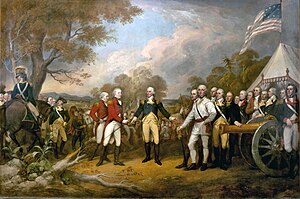Everything about the Battle of Saratoga–including its name–has been scrubbed clean by scores of textbooks.
On October 17, 1777, after a punishing four-month campaign, British general John Burgoyne surrendered almost 6,000 British, Hessian and Canadian troops to the Northern Department of the Continental Army, led by General Horatio Gates and (they should get all the credit for victory) Generals Benedict Arnold and Daniel Morgan.
It was a stunning victory, one that would have widespread effects on the Revolutionary War. Yet many of the details have been lost to the chest-thumping.
Burgoyne left Canada in June of 1777 with a force that was designed to connect with two other British forces: Barry St. Leger‘s mixed army of British, Hessian and Native troops from the west, and Sir William Howe‘s main British force from New York City. They were supposed to meet near Albany, dividing the colonies in two and effectively ending the war and the American Revolution.
It didn’t exactly go as planned.
First to punk out was Howe. It was, on the surface, an easy choice: George Washington’s army was being driven from Pennsylvania, and the rebel capital, Philadelphia was poised for the taking. To him, it made more sense. Never mind that the plan to effectively end the war was fucked up from the very beginning–Washington was the bigger prize. It would be a prize Howe would never get, and would soon be relieved by Sir Henry Clinton.
St. Leger had an even worse time. He never had any intention of backing out: his mixed force of 2000 Loyalists, British and natives crossed Lake Ontario and landed at Oswego on July 25. The brutal campaigns of Oriskany and Fort Stanwix–where American militiamen and native allies slugged it out with St. Leger’s forces to a stalemate–changed the story. It drained the morale of St. Leger’s native allies, who took their supplies and took off. It didn’t help that Benedict Arnold tricked St. Leger into thinking a larger colonial force was coming to relieve Fort Stanwix. By the time St. Leger shows up at Fort Ticonderoga on September 27, his feeble force was no help to Burgoyne.
Of the three prongs on the British plan, it was Burgoyne, funny enough, who was most successful. By July he had retaken Fort Ticonderoga, an important strategic and symbolic fortification on the foot of Lake Champlain. Yet from then on, his campaign slowed to a crawl, as the wagons crating the supplies–including Burgoyne’s luggage, china and furniture–got bogged down in the Hudson highlands.
In the meantime, a quick American victory over Burgoyne’s advance cavalry at Bennington boosted morale to the point that American forces would swell to close to 15,000. It included Daniel Morgan’s Virginia sharpshooters, Benedict Arnold’s force sent to relieve Fort Stanwix, as well as the main force under Benjamin Lincoln and a new commander, British trained Horatio Gates.
Gates thought he could do a better job than Washington. Arnold thought he could do a better job than Gates. Both hated each other.
So how was Saratoga won?
Saratoga was not one battle, but rather a series of maneuvers and two battles over on month. The first, the Battle of Freeman’s Farm, the British technically won, but at the cost of 600 casualties. On October 7, the British attacked American fortified positions at Bemis Heights. In the two actions–the second punctuated by a daring attack by Arnold who was probably drunk–the British suffered a total of 1000 casualties.
Outnumber three to one, with the Americans controlling the high ground and surrounding him at the town of Saratoga itself, Burgoyne was forced to surrender his forces. When he discussed the terms with General Gates, Burgoyne insisted on calling the surrender a “convention” rather than a “capitulation.”
He fooled no one.
On the final ceremony, after Burgoyne offered his sword to Gates (who refused–a move that further infuriated Arnold), 6000 soldiers laid down their arms as the band played “Yankee Doodle.”
It was very clear to everyone this was no “convention.”
Saratoga would invoke the first day of Thanksgiving, decreed by the Continental Congress on December 18, 1777. It convinced France and Spain that the Americans could actually win the war–given the right support. Soon, both countries would sign treaties of alliance with the United States, transforming a colonial rebellion into a world war.
Below is a two-part short documentary about Saratoga narrated by Dan Roberts.
Filed under: Uncategorized Tagged: American History, Battle of Saratoga, Benedict Arnold, Burgoyne, Commentary, current events, Daniel Morgan, Education, European history, Fort Stanwix, Fort Ticonderoga, Great Britain, History, Horatio Gates, John Burgoyne, Media, motion pictures, movies, Native Americans, New York History, Opinion, Social studies, Teachers, Teaching, television, U.S. History, United States, war, World History





















